
Thermal modeling and analysis of 193 nm pulsed excimer laser calorimeters PDF
Preview Thermal modeling and analysis of 193 nm pulsed excimer laser calorimeters
THERMALMODELINGANDANALYSISOF193nmPULSEDEXCIMER LASERCALORIMETERS By DONGHAICHEN ADISSERTATIONPRESENTEDTOTHEGRADUATESCHOOL OFTHEUNIVERSITYOFFLORIDAINPARTIALFULFILLMENT OFTHEREQUIREMENTSFORTHEDEGREEOF DOCTOROFPHILOSOPHY UNIVERSITYOFFLORIDA 2001 ACKNOWLEDGEMENTS ItakethisopportunitytoexpressmysincereappreciationtoDr.ZhuominZhang forhis constant guidance, encouragement and support. He is always helpful in the achievementofmygoalsandprovidesalotofhelpbeyondtheresearchwork. Iwould alsoliketothankDrs.JacobChung,DavidHahn,JillPeterson,andDavidTannerfor servingonmysupervisorycommittee. I also gratefully acknowledge Drs. Marla Dowell, Christopher Cromer, and ThomasScottoftheNationalInstituteofStandardsandTechnology(NIST)forproviding valuableinformationandgivingmeachancetoworkatNIST. Iamthankfultomy colleaguesintheMicroscaleThermalRadiationLabfortheirassistance. Ialsoextend mythankstoDr. RaviKumar, DavidPearson, FerdinandRosa, andJorgeGarciafor helpingmetoimprovemyEnglish. Iextendmywarmestthankstomyparentsanddearwifewhohavebeenasource ofgreatinspirationandsupportthroughouteverychallengeinmylife. The final thanks go to the financial supporters ofthis project: the National InstituteofStandardsandTechnology,andtheNationalScienceFoundation. n TABLEOFCONTENTS page ACKNOWLEDGEMENTS ii ABSTRACT v CHAPTERS 1 INTRODUCTION 1 2 DEVELOPMENTANDAPPLICATIONSOFLASERCALORIMETERS 5 BriefReviewofCalorimeters 5 CWLaserCalorimeters 9 Pulsed-LaserCalorimeters 11 BasicPrinciplesofLaserCalorimetryandtheCalibrationSystem 14 3 THERMALMODELANDNUMERICALSIMULATIONMETHOD 23 PreviousStudyofLaserHeating 23 ThermalModelDevelopment 25 NumericalSimulationMethod 30 4 ANALYSISOFTHERMALMECHANISMSINVOLUMEABSORBER 38 ThermalModelofthe193nmCalorimeter 38 Three-DimensionalModeling 42 AxisymmetricModeling 47 AnalysisoftheProposedDesign 50 5 MULTIPHOTONABSORPTIONINVOLUME-ABSORBINGGLASS 67 Introduction 67 LaserIntensityandPenetrationDepth 68 TheAxisymmetricHeatingModel 72 ResultsoftheNumericalModeling 75 6 PARAMETRICSTUDYOFEXCIMERLASERCALORIMETERS 86 m TheFiniteElementModel 86 ResultsandDiscussion 89 7 AXISYMMETRICMODELINGOFTHECALORIMETERCAVITY 99 AxisymmetricModeloftheCavity 99 ResultsandAnalysis 102 8 NONEQUIVALENCEANALYSISOFLASERCALORIMETERS 112 ThermalModeloftheCavity 112 NonequivalenceAnalysis 118 9 SUMMARYANDCONCLUSIONS 130 ThermalMechanismsoftheVolumeAbsorber 130 ParametricStudyoftheLaserCalorimeter 132 NonequivalenceoftheLaserCalorimeter 132 APPENDIX NOMENCLATURE 134 REFERENCES 138 BIOGRAPHICALSKETCH 143 iv AbstractofDissertationPresentedtotheGraduateSchool oftheUniversityofFloridainPartialFulfillmentofthe RequirementsfortheDegreeofDoctorofPhilosophy THERMALMODELINGANDANALYSISOF193nmPULSEDEXCIMER LASERCALORIMETERS By DonghaiChen May2001 Chairman:ZhuominZhang MajorDepartment:MechanicalEngineering Thisworkdescribesthethermalmodelingandanalysisofpulsedexcimerlaser calorimetersatawavelengthof193nm. Differentthermalmodelshavebeendeveloped and the finite element method is employed to perform the thermal modeling ofthe volumeabsorberandthecavityinthe193nmlasercalorimeter. Inthiswork,theheatgenerationratesinvolumeabsorberandtheheatfluxonthe coppersurfacehavebeenderivedandthefiniteelementmethodisemployedtosimulate thespace-andtime-dependenceoftemperatureintheabsorber. Athree-dimensional modelandanaxisymmetricmodelhavebeenbuiltandusedtostudytheheatingeffects ofsinglepulseandmultiplepulses,respectively. Theproposeddesign, inwhichthe volumeabsorberisnotopticallythick,wasanalyzedunderconsiderationofthereflection andabsorptionattheinterface.Thecomparisonofthepresentdesigntotheproposed designshowsthatthe accuracyanddynamic range canbe improved forthevolume v absorberwithlowabsorptioncoefficient. Thetwo-photonabsorptioninthevolume- absorbingglassisinvestigatedandtheresultsshowthatthetwo-photonabsorptioncan compressthevolume-absorbingeffecttosurfaceabsorptionwithhigh-power,short-pulse laserirradiation. Theparametricstudyofexcimerlasercalorimeterhasbeenperformedforpulsed- laserheating,average-powerlaserheating,andelectricalheatingusingtheaxisymmetric modelinwhichthevolumeabsorberwithsmallthicknessandhighabsorptioncoefficient wasconsidered. Themaximumtemperatureishigherforpulsed-laserheatingthanfor electrical heating when the amount of total deposited energy is the same. The equivalencebetweenpulsed-laserheatingandaverage-power laserheatingisverified throughtheaxisymmetricmodelingofthecavity. Athree-dimensionalmodelofthefull cavityisemployedtopredictthecalibrationfactorforlaserheating. Thenonequivalence ofthelasercalorimeterisevaluatedbasedontheresultsofthefullcavitymodeling. Detailedthermalmodelingandanalysisoflasercalorimeterareprovidedwhichhelp understand the thermal response ofthe volume absorber and the cavity under laser heatingandelectricalheating. Thisworkwillhelpimprovethefuturedesignofpulsed- lasercalorimeters. vi CHAPTER 1 INTRODUCTION Excimerlasershavebeencommerciallyavailablesince1975andarewidelyused in a number of applications demanding the highest resolution in addition to semiconductor manufacturing, such as micromachining, heat-sensitive materials processingandphotorefractivekeratectomy(PRK). Themostpopularwavelengthsare 157, 193, 248, 308, and 351 nm. Applications of248 nmpulsed excimer laser in semiconductor industry led to the construction ofcalibration system forpulsed-laser energy/powermetersatthiswavelength. Calibrationtechnologiesforenergy/powermetersofpulsedexcimerlaseratthe wavelengthof193nmaremotivatedbyitsscientific,industrialandmedicalapplications. Inmedicalapplications,suchasPRK, 193nmexcimerlaserisusedtoremovetissue precisely from cornea to correct the diopter with the minimum heat effects on surroundingtissue(Patzel,1999). TheSemiconductorIndustryAssociationroadmaplists 193nmexcimerlaserasoneimmediatecandidateforprintingfeatureof0.18pm,along with extensions of248 nmexcimerlaser(Rothschildetal., 1997). The wavelength change from 248 to 193nm in photolithographic techniques and other applications requiresparallelprogressinthecalibrationtechnologies. Lasercalorimeters,knownfor their long-term stability and overall accuracy, are widely used to calibrate laser energy/powermetersatdifferentwavelength. Hence,itisnecessarytobuildcalorimeter 1 2 forcalibratingenergy/powermetersofpulsedexcimerlasersat193nmbasedonDUV calorimetersatthewavelengthof248nm(LeonhardtandScott,1995). Anisoperibollasercalorimeterconsistsofanabsorbingcavitythatissurrounded byaconstant-temperatureheatsink(Westetal., 1972). Laserenergy(orpower)is absorbedbythecavityandconvertedintointernalenergyoftheabsorbingcavity. The temperaturedifferencebetweenthecavityandtheheatsinkisameasureoflaserenergy (orpower). Electrical-calibrationmethodsprovideadirectcomparisonbetweenoptical andelectricalheatingthuseliminatingtherequirementforprecisemeasurementsofa calorimeter’s thermal properties. Electrical-calibration methods also provide direct traceability to SI units and improve calibration accuracy (WestandChumey, 1970). Calorimetershavebeendesignedtooperateatspecificwavelengthsandpower/energy levelsbythecarefulselectionofabsorbingmaterialsforthecavity. Surfaceabsorbers, suchasblackpaint,havebeenwidelyusedincalorimetersforlowpower,continuous- wave (CW) measurements. However, surface absorbers arenotappropriate forhigh power pulsed-laser measurements because the high transient temperature gradients producedatthesurfacecanleadtosurfacedamage. Forthisreason,volume-absorbing materials, which disperse the absorbed energy over a larger volume, are used in calorimetersforpulsed-lasermeasurements. Itisimportanttoselectavolume-absorbingmaterialappropriateforthepulsed excimerlaserat193nmbecausethelong-termexposuretohighpeakpoweroutputfrom excimerlasers,aresultofhighphotonenergiescombinedwithshortpulsewidths,causes damagetomostconventionalopticalmaterials. Inaddition,thehighpeakpowerofthe 193nmpulsedexcimerlasercanresultinahightemperatureonthesurfaceofvolume 3 absorberandanonequivalencebetweenpulsed-laserheatingandelectricalcalibration, whichlimitthedynamicrangeandaccuracyofcalorimeter,respectively. Concernsfor theseissuesaremainlythethermalresponsesofthevolume-absorbingmaterialtopulsed- laserheatingandelectricalheating,andtheuncertaintyofthepulsed-lasercalorimeter. Therefore,thermalmodelingisperformedtopredictthethermalresponsesofthevolume absorberandthecavity. In the present study, the main objectives are to understand the heat transfer mechanisms in the volume-absorbing glass with different thickness and absorption coefficients,toevaluatethenonequivalenceofthepulsedlasercalorimeter. Different thermalmodelarebuiltusingthefiniteelementsoftwareANSYS5.4-5.6,basedonthe 193nmlasercalorimeterinwhichtheabsorbersarevolume-absorbingglass. Athree- dimensionalmodelofthevolumeabsorberisusedtostudythesingle-pulseheating. An axisymmetricmodelofthevolumeabsorberisemployedtomodelthemultiple-pulse heating,performtheparametricstudyofexcimerlasercalorimeters,andinvestigatethe multiphotonabsorption inthevolume-absorbingglass; anaxisymmetricmodelofthe cavity is built foranalyzing the difference between thepulsed-laserheatingandthe average-powerlaserheating;athree-dimensionalmodelofthefullcavityisdevelopedto predictthenonequivalenceofthe193nmpulsed-lasercalorimeter. Theorganizationofthisdissertationisasfollows. Chapter2presentsareviewof thedevelopmentandapplicationsoflasercalorimeters. Thethermalmodelofvolume- absorbingglassirradiatedbylaserpulseandabriefreviewoftheworkrelatedtolaser heatingaredescribedinChapter3. Thethermalmechanismsofthevolume-absorbing glassunder193nmpulsed-laserirradiationandtheinfluenceoftheabsorptioncoefficient 4 onthethermalresponseoftheglassareanalyzedinChapter4. Multiphotonabsorption in the volume-absorbing glass under 193 nm pulsed-laser irradiation is presented in Chapter5. TheparametricstudyofexcimerlasercalorimetersisdescribedinChapter6. Theequivalencebetweenthepulsed-laserheatingandtheaverage-powerlaserheatingis analyzedinChapter7. Thenonequivalenceofthe 193nmpulsed-lasercalorimeteris predictedinChapter8. Finally,summaryandconclusionsaregiveninChapter9.
